I’ve become a fan of This Week in Travel and Amateur Traveler podcasts. The podcasts are interesting; informative; and peopled with knowledgeable, fun, and sometimes irreverent personalities. Just my kind of listening enjoyment. One of their recent podcasts conjured up memories of penguins and the Antarctic. I thought I would steal their idea and name this travel “vacation” – Penguincation.
My friends and I flew from Buenos Aires to the southernmost tip of the world, Ushuaia (U swhy ah), a relatively small town in the province of Tierra del Fuego located below the Andes on the Beagle Channel. This “World’s End” clings to prosperity by catering to 65 boatloads of tourists a year. Reminiscent of Alaska with the ever-present chill of snow and glaciers in the Andes, hardy locals wear t-shirts and tourists dress like Michelin Tire boys and girls. We walked about town as snow fell and purchased a flag and enough alcohol to take us through the Antarctic. Travel shops about town advertising 50% reductions for last-minute spaces on departing ships broke my budget-seeking heart. However, Ushuaia is a long way to travel to look for potential bargains so I quickly moved on.
The afternoon of December 8, we arrived at the moment we had been planning for a year – boarding the Ocean Nova (formerly the Sarpik Ittuk) for 19 days of Antarctic Exploration.
“South” – this word says it all. The environs of the sub-Antarctic and Antarctic Continent are an immense, unique part of the world. It is remote, hard-to-reach, hostile and visited by few. And it deserves this reputation. It might be researched and better understood in the 100 years since the explorations of Sir Ernest Shackleton and Robert Scott during the Heroic Age (1882-1917), but the Antarctic is not “conquered.”
A ship can sail for days and never see another ship or anything other than pelagic birds and marine life. The sun set at 11:30 pm leaving a sort of twilight before it rose over rolling seas at 2 am. It is windy and changeable weather. South is to find your self within endless, rolling seas, loosing all sense of direction, time and place. South is fascinating as there is no other place like it in the world.
Rolling seas can be bruising for the unsuspecting traveler. I sleep with the ship rolling probably 15 to 20 degrees side to side. My body slides from one end of the bed to the other, and if not my body, my internal organs slosh in my chest. Seas are not conducive to showers, dressing, or eating upright. No seasickness for me but I tire of the relentless tossing about.
We reached the Falklands in 36 hours and made two Zodiac landings: West Point Island and Carcass Island. Bare rock, no trees, wind blown and with rookeries of Black-browed Albatross, Rockhopper and Gentoo penguins in the thousands. Open fields to walk, a rugged life where two self-sufficient families live on an island with 50,000 penguins and countless birds. The Napier family is welcoming but very isolated. Locals, who are British, were surprised when Argentina invaded in 1982. It took weeks for British ships and planes to arrive to fight off the invaders, doing so in a matter of days. Memorials both here and in Buenos Aires indicate the seriousness of the war and relations remain contentious. For Argentines, Falklands remains Islas Malvinas. Our second day, we dropped anchor at Port Stanley for a ride to Gypsy Cove and a closer look at Magellanic penguins before we walked about Stanley to enjoy the museum and a beer.
South Georgia is a comfortable two days at sea and even more isolated. At sea, we listen to lively lectures on history, geology, birds and marine life. Expedition Leader Laurie Dexter told us of his 91-day ski trip from Russia to Canada. Rob is the youngest Aussie to ski to the North Pole. This explains their vigor and enthusiasm for what they do. December 13 off South Georgia we spot our first iceberg as big as our ship. Also about this time we pass through the Antarctic Convergence where the cold northerly-flowing Antarctic surface water with its low salinity meets the warmer southern flowing sub-Antarctic surface water that is high in salinity. The turbulence and mix in this area creates a rich feeding ground for birds and other marine life.
We arrive at Elsehul in choppy seas and find it too dangerous to land a Zodiac. The beach is filled with Fur and Elephant seals and the ever-present penguin. We make 7 additional stops during our four days around South Georgia. Salisbury Plain allows us close contact with seals and pups, a large King penguin colony, and our first sighting of reindeer (introduced by the Norwegians). Fortuna Bay and Stromness Harbour (between which Shackleton walked across towering mountains for help) afford us exploration of an old whaling station, rather aggressive Fur seals and friendly penguins. The next morning we Zodiac St. Andrews Bay (big surf so no landing), home to the largest King penguin colony we will see. It is impossible to describe over 300,000 adults and at least 150,000 ‘fuzzy wookie’ juvenile penguins flowing along the beach, up the hills and into every spot possible. Nor to describe the sound and smell. Fur and Elephant seals compatibly live amongst them.
Penguin rookies are mind-boggling. As I admire the black and white of rugged snow-capped mountains and glaciers, I am aware of the unmistakable color, movement, sound and smell of a half million penguins. To walk among them is to experience awesome numbers, adoption by begging wookie chicks, and a mix of animal species. Nesting together are Albatross; Gentoo, King, Adélie, Chinstrap, Magellanic, Macaroni and Rockhopper penguins; Fur, Crabeater, Weddell, and Elephant seals. Real estate is premium. I question penguin intelligence as they trudge a mile or more from beach to nest, often up several hundred feet of rocky promontory, making the trip not only to feed but to bathe and hang out on the beach with friends. There are no land predators here so why walk so far? Have they been told about “location location location”? The Gentoo are burrowers and trudge from beach to rocks on their funny, adaptable feet. Kings cluster around the beaches and on mostly level ground; Rockhoppers climb sheer cliffs to reach their “prime view” nesting places.
Fur seals, especially the days-old pups, are adorable. Black with big dark eyes, the pups growl and practice fierceness in spite of their little stature. Others come up to seek comfort while mom is out foraging for food. Male Fur seals are aggressive and territorial but whine like puppies as they worry about our presence. Adults have a pointy nose, almost rat-like faces and big teeth. Elephant seals are said to be larger here but their proboscis is not as pronounced as our Northern Elephant Seal. These big seal barely open their huge black eyes to check us out before going back to sleep.
We are excited to sail for Grytviken in South Georgia. In winter, only 14 people remain at this “capital” to maintain its church, museum and post office. But what makes this historic whaling station important is the Whalers’ Cemetery. Here Sir Ernest Shackleton is buried. And I am about to experience two of the most fantastic experiences of my life.
- Salisbury Plain, South Georgia
- King Penguins on Salisbury Plain
- Looking for food and conversation
- King penguin stages of maturity
- Wookie friend
- It helps to be bilingual
- Black-browed Albatross
- Yorke Bay, Falklands
- Fur seals
- Rough seas
- Lurking icebergs
- Friends in Ushuaia

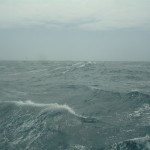
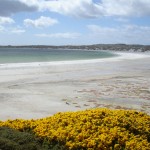
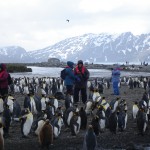
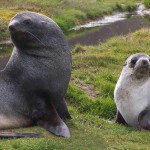
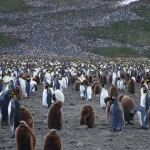
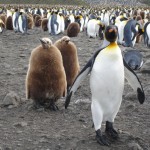
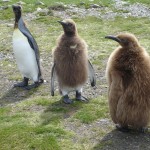
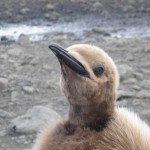
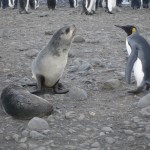
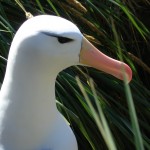

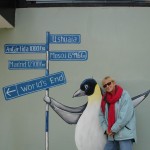

0 Comments